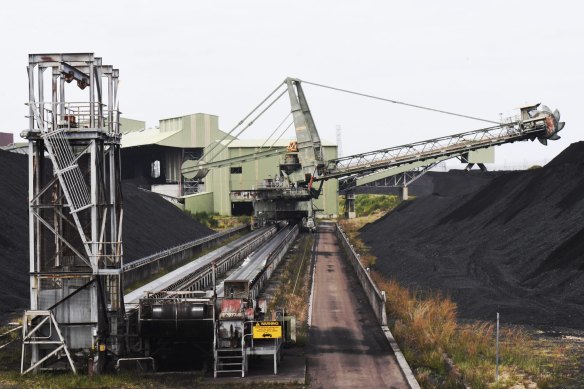This was published 1 year ago
NSW mulls extending life of biggest coal plant to avoid power shortfalls
By Laura Chung
The NSW government expects to make a call by the end of the year on whether it will intervene to help keep Australia’s biggest coal-fired power station open beyond 2025.
The state government is racing to get more renewable energy, network and storage projects online to curb any possible energy shortfalls before the scheduled retirement of four out of five NSW coal-fired power stations over the coming decade.

The closure of Eraring could raise issues for the state’s power supply, but the industry and government are watching closely.Credit: Nick Moir
Of particular concern will be Origin’s Eraring coal-fired power station, which is set to close as early as 2025.
Data from the Australian Energy Market Operator (AEMO), presented to NSW Energy Minister Penny Sharpe on Wednesday, shows gaps in the market begin to emerge from 2025 to ’26 if Eraring closes: a shortage of 262 megawatts, and a shortfall of 62 megawatts the following financial year.
However, the report notes the forecasts do not anticipate additional storage and generation projects which will help close the gap.
Senior department officials said up-to-date information on whether the government would have cause to intervene would be available by the end of the year.
Labor has previously floated the idea of a buyback scheme to keep the plant open. In Victoria, the government subsidised EnergyAustralia’s Yallourn coal-fired power plant.
Origin has committed to continuing to assess market conditions before making decisions on the timing of the closures of Eraring’s four units to ensure the grid is equipped to handle their withdrawal.
“Origin will ... continue to actively engage with the market operator, NSW government, our people and the local community regarding plans for Eraring’s closure,” the company said.
The company was granted the green light to build a large-scale battery on-site in its place earlier this week.
Federal Energy Minister Chris Bowen told the ABC on Wednesday that the government was doing everything it could to ensure there were no shortages come 2025, but said there was more to be done.
“We are dealing with a big challenge here,” he said. “Our transition needs to be faster, but it also needs to be a lot more orderly.”
Earlier this month, Premier Chris Minns said while the closure of Liddell wouldn’t impact energy generation in the state, the closure of Eraring could. The site provides about a quarter of NSW’s fossil fuel-based energy, with an overall generating capacity of 2922 megawatts.
“We know that there’s a big challenge coming around the corner ... particularly in relation to Eraring, [with] baseload supply of power in the state of NSW,” Minns said at the time. “But we’re getting the building policy pieces in place to ensure we can manage the renewable energy revolution in the state.”
AEMO executive general manager of system design Merryn York said that NSW had many proposed generation and storage projects that are yet to be approved, which – if delivered on time – will offset the planned generation retirement.
Sharpe previously told this masthead that she wouldn’t rule any options out.
“My job is to keep the lights on and to make that transition as quickly as possible. None of us want the coal-fired power plant being open longer than it needs to be, but we’ve also got a responsibility to make sure that households and businesses can go about their business,” she said.
The government has announced it will establish an energy security corporation: a publicly owned company that will accelerate renewable energy production.
with AAP